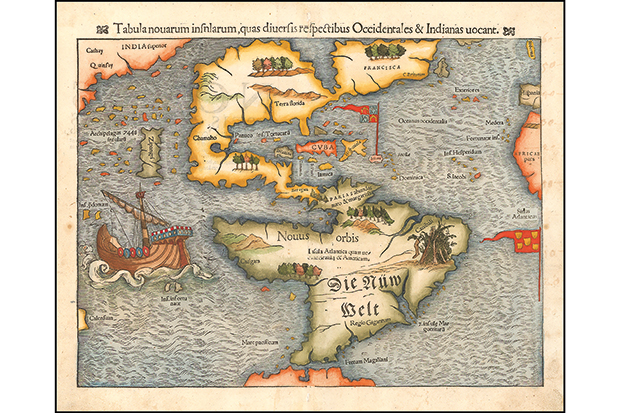In his Forward Prize-winning collection of 2014, A Cartographer Tries to Map a Way to Zion, Kei Miller’s hero describes his craft thus: ‘My job is to imagine the widening/ of the unfamiliar and also/ the widening ache of it;/ to anticipate the ironic/ question: how did we find/ ourselves here.’ This bringing of the unfamiliar into scope looms large in three new collections of cartographic curiosities which tell us about places that never were, places we’ve never been and places we will never go to.
Edward Brooke-Hitching’s beautifully illustrated The Phantom Atlas presents the stories of over 50 locations that unwarrantedly found their way on to maps. In many cases these ‘places’ were the fault of misrecording and misreporting, the progeny of the weary confusion of those far from home. Having fixed themselves in one map, they were replicated and disseminated until such time as they were — like learned theorems — disproved. What is most remarkable is the sheer length of time for which some errors persisted. It might be expected that Edwardian explorers sent telegraphs proclaiming the anti-discovery of islands charted centuries earlier. It is, however, a little brain-boggling that the island of Bermeja (supposedly off the north coast of the Yucatán peninsula) was only finally eliminated from maps in 2009.
Brooke-Hitching’s book is, in part, an excursion into the minds of men imagining an as yet uncharted world — one in which Australia might have a large central sea — or reporting the confused rumours of earlier travellers. The medieval Icelandic Book of Settlements, the Landnámabók, recounted how a tenth-century explorer, Ari Marsson, had a ship which was driven by a tempest to a place near Vinland, which he called Greater Ireland. Stories of this island spread and somehow caused it to appear in the works of the 12th-century Arab geographer, Muhammad al-Idrisi.
Among Brooke-Hitching’s subjects is a detailed dive into the world of the Nuremberg Chronicle Map. This was a sort of Hitchhiker’s Guide to the Galaxy of yesteryear, which made note of how very odd foreigners could be, what with some of them having six arms, being half-horse or having no head. Brooke-Hitching notes that the written origins of such folk can often be traced to the works of Pliny and the legends of Alexander — though there may be further to go. The race of chaps with extended necks and beaks could derive from mangled accounts of neck-stretched and lip-plated African peoples, and the monocular men of the far north seem to speak of one-eyed Odin, god of the Norse.
 Tabula novarum insularum by Sebastian Munster (Basle, 1550). Both illustrations from The Phantom Atlas by Edward Brooke-Hitching
Tabula novarum insularum by Sebastian Munster (Basle, 1550). Both illustrations from The Phantom Atlas by Edward Brooke-Hitching
The Nuremberg Chronicle’s desire to catalogue and promote the joltingly bizarre runs through two other new atlases: Atlas Obscura, by an intrepid internet trio, and Travis Elborough’s Atlas of Improbable Places. The ‘atlas’ was obviously named after the titan whose hard lot it was to hold up the celestial spheres, and whose image adorned a 1595 collection of maps published by the Dutch cartographer Gerhardus Mercator (presumably because his was an Atlas-eye-view of the world). Mighty Atlas bore not only the globe’s boundaries but all the peculiarities contained within them — something that Atlas Obscura and its parent website seem to aspire to do.
Less a collection of maps and more an intriguing inventory of hundreds of oddities, it references a soothsaying creature — half fox, half woman — who lives in Karachi Zoo; the medieval Bantu city of Great Zimbabwe; a Thai Buddhist temple constructed from beer bottles; the phallic tombstones of Golestan (Iran); the world’s largest ball of paint; and the ‘tempest prognosticator’ of Okehampton (a meteorological device powered by the cognisance of leeches).
Travis Elborough’s improbable places are similarly surprising — a series of architectural and societal anomalies obliged by history to be different. We are reminded of the unlikely relocation, in 1971, of the 130,000 tons of London Bridge to Lake Havasu City, Arizona; we learn of the ruined ancient city of Ani in east Turkey — once the capital of the Armenian empire — and see the massive, forgotten African Renaissance Monument — the tallest
statue in Africa — in Senegal.
Reassuringly compelled by the bleak, Elborough also takes us to Zheleznogorsk (a former closed Soviet city in one of Siberia’s quieter corners); to Wittenoom, an asbestos-ridden industrial town in Western Australia, abandoned in 1966; and to the horrific-sounding ‘Island of Dolls’ in Xochimilco, Mexico. He is a brilliant guide to places we are never likely to take the family on holiday but still rather hanker to see.
These books are wonderfully strange, though in creating such ready accessibility in print and online they almost pluck out the heart of their subjects’ mystery. (There is something profoundly comforting in having only a small number of photographs in Elborough’s well-mapped book.) Fortunately, odd things keep popping up — as do islands. Seven have appeared in the past decade, including, most recently, Hunga Ha’apai in Tonga. Such ever-shunting tectonics — physical and political — ensure that the atlas-maker’s job will never quite be done.
The post Atlas shrugs appeared first on The Spectator.
Got something to add? Join the discussion and comment below.
Get 10 issues for just $10
Subscribe to The Spectator Australia today for the next 10 magazine issues, plus full online access, for just $10.
You might disagree with half of it, but you’ll enjoy reading all of it. Try your first month for free, then just $2 a week for the remainder of your first year.














Comments
Don't miss out
Join the conversation with other Spectator Australia readers. Subscribe to leave a comment.
SUBSCRIBEAlready a subscriber? Log in